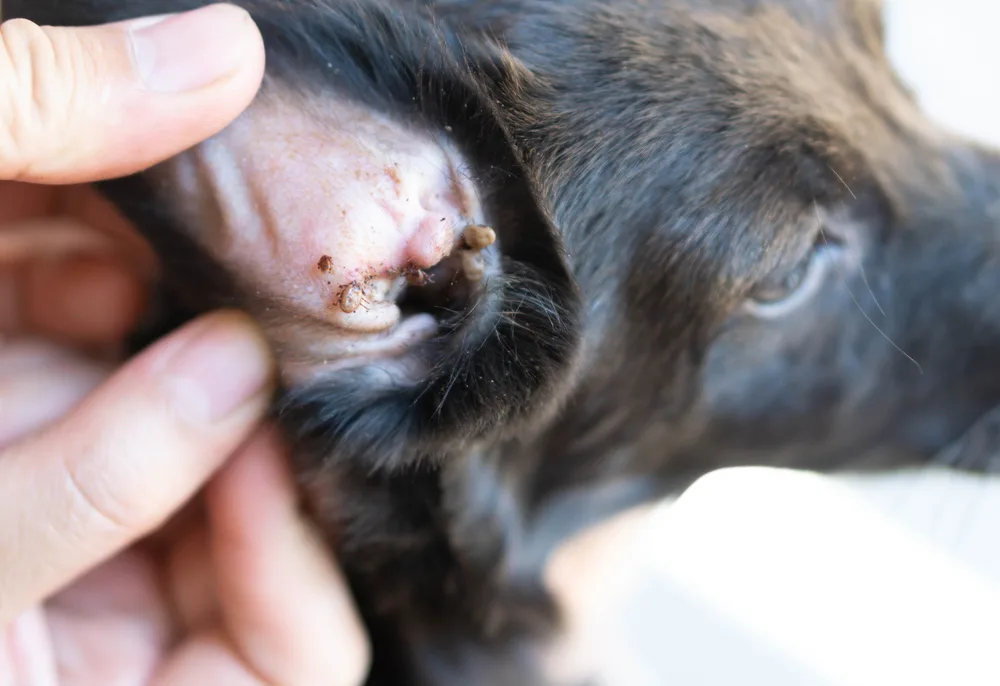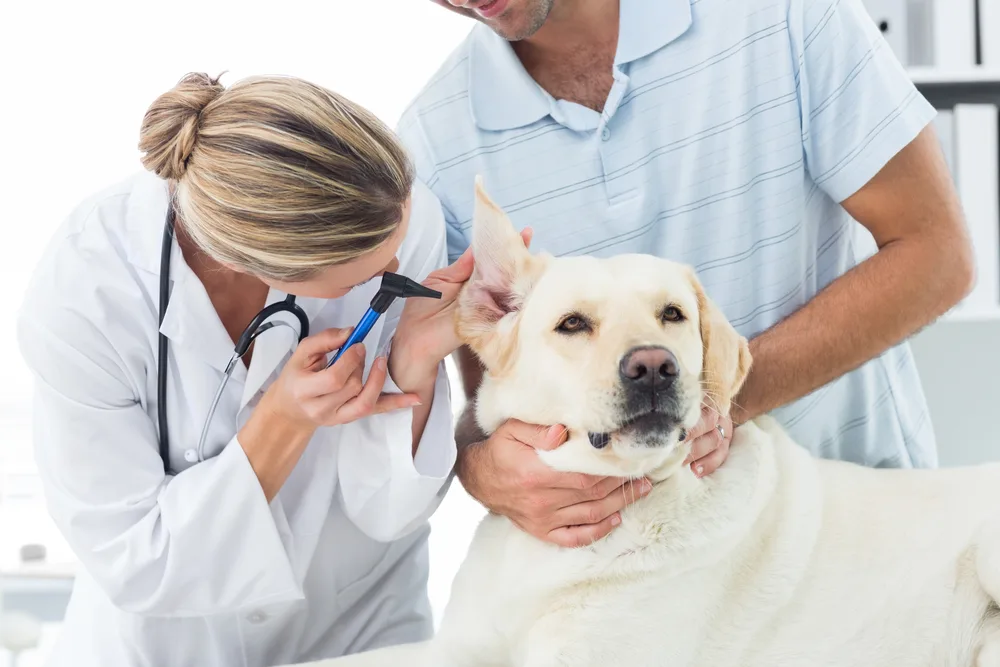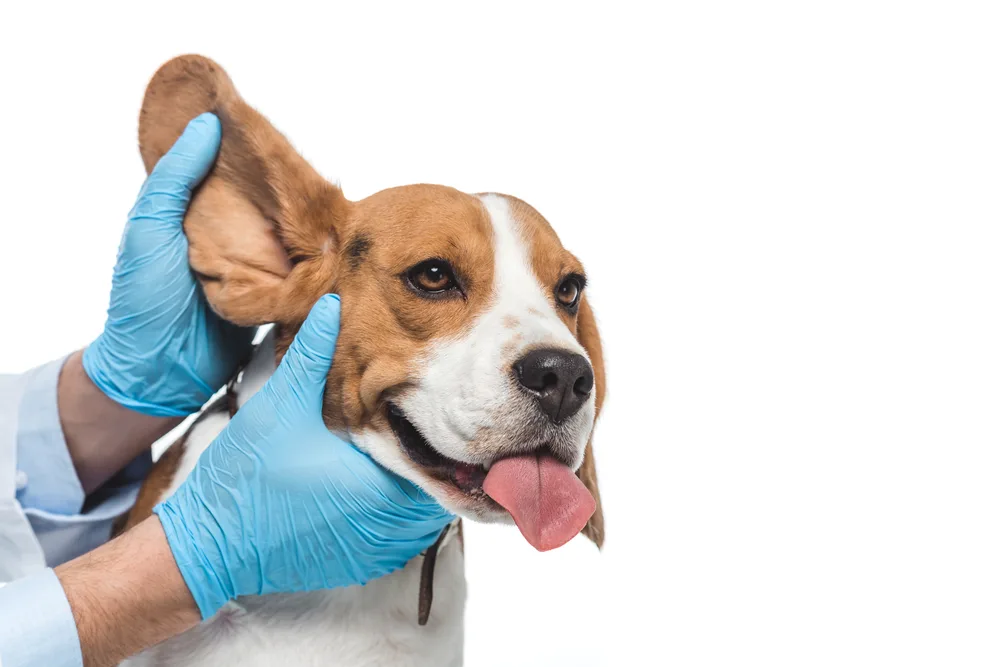Medically Reviewed by Dr. Majid Tanveer, DVM
Ear infections are frequent for our four-legged friends, particularly those with long ears. If neglected, ear infections can bring about immense agony and potentially more substantial health concerns.
Does your cuddly companion deal with chronic ear infections? If so, do you know about different ear infections and how to deal with them?
Ear infections in dogs are common and can cause pain and discomfort. They occur when the ear canal is inflamed and filled with fluid, often due to an accumulation of bacteria or yeast. The symptoms include redness and swelling inside the ear flap, a foul odor, head shaking, and drainage from the ear. If left untreated, an infection can lead to hearing loss or even damage to the inner ear structures.
In this article, we’ll discuss the different types of ear infections in dogs, their causes, and how to treat them. So let’s move on!
What Makes Dogs’ Ears More Susceptible to Ear Infections?
Dogs with stocky, dangling ear flaps are much more vulnerable to ear infections than those dogs whose ears stand up.
Dog ears have several other features that make them more prone to ear infections than other animals. These are:
- Dogs have a much more vertical ear canal than humans, which creates an L-shape that helps to keep the fluid inside.
- Dogs also produce more wax, creating a warm, moist environment where the growth of bacteria is favored.
- Dogs prone to allergies may be more at risk of developing an ear infection.
Types of Ear Infections in Dogs

Ear infections can be classified into three distinct categories based on their corresponding ear part or structure involved. These are:
- Otitis Externa
- Otitis Media
- Otitis Interna
Otitis: Infection or inflammation of the ear.
Otitis Externa
The external auditory canal, often called the ear canal, is a tube-like structure that runs from the outer edge of your dog’s ear and sends sound waves into the eardrum.
Otitis externa frequently affects the outer ear and auditory canal, resulting in swelling in the cells lining both canals.
Otitis Media
A tube connects the middle ear directly behind the eardrum and the throat’s back.
Otitis media occurs when fluid builds up in this area, which can be caused by inflammation or infection from bacteria, viruses, or yeast. It is primarily an extension of Otitis externa.
Otitis Interna
The inner ear is a complex system of interrelated structures, including the cochlea, which converts sound waves into electrical impulses that travel to the brain.
Otitis interna occurs when there is inflammation and infection in inner ear structures, causing hearing loss, facial paralysis, or vestibular signs in your dog.
Based on the duration of the infection, an ear infection can be classified as:
- Acute Ear Infections: Ear infection is of short duration and can be treated with medications.
- Chronic Ear Infections: Ear infection persists for a more extended period and thus requires more aggressive treatment and frequent check-ups.
Are Dog Ear Infections Contagious?
Ear infections are not contagious from humans or pets to other animals. However, certain parasites, such as ear mites, can transmit.
When your veterinarian diagnoses your pup with ear mites, all animals in the household should be treated for potential infections of these parasites.
Yeast infections are the most common but are not contagious between dogs! Bacterial infections also tend to be non-communicable.
Having a pup licking another dog’s ears can negatively affect his health. It may lead to discomfort and soreness in the ear lobe or, even worse, an infection in the auditory canal.
What Causes Ear Infection in Dogs?

Bacteria are the primary source of ear infections in dogs, yet yeast and fungus can also inflate your puppy’s ears.
Ear infections in dogs may have other various underlying causes. A few of the more common ones are as below:
Environmental Allergies
Ear infections in dogs can be caused by several environmental allergies, including:
- Mold
- Pollen
- Dander
When the protective skin barrier of the ear canal is weakened due to allergies, certain fungi, and bacteria can begin to grow. This growth leads to painful inflammation and discharge that can cause chronic issues with the opening of your ear canal.
Ear Mites
Ear mites are usually black and induce immense pain and irritation in your dog’s ear. These parasites feed on the dead skin cells, which leads to inflammation that perpetuates the infection. Numerous issues can arise from having ear mites present in your pup, such as:
- Bacterial infections
- Inflammation in the ear canal
- Partial or complete deafness
Ear mites are known to lay eggs, which must be eliminated for a successful resolution. Traditional ear mite medications may eliminate the grown-up mites but leave behind their eggs.
Endocrine Issues
The endocrine disease may be the culprit if your dog repeatedly suffers from otitis externa without being itchy. These endocrine disorders affect your dog’s metabolism, but they can also have a dramatic impact on his skin:
- Diabetes
- Hypothyroidism
- Cushing’s disease
So as animals age, the delicate skin may become more vulnerable to irritations or infections in areas such as the ears. Endocrine issues can require lifelong management to ensure your dog stays healthy and happy.
Food Allergies
When the body mistakenly identifies a harmless food protein as an intruder, it activates an immune response – thus creating a food allergy. Ultimately, your dog may develop an itchy skin rash or ear and skin infections due to this reaction.
Tumors
Prolonged ear canal inflammation can lead to tumor formation, often caused by abnormal tissue growth. Fortunately, most tumors in the ears are usually Benign.
There are many types you should be aware of when it comes to ear tumors. These include:
- Tissue tumors of the inner and outer ears
- Bone tumor
- Middle ear tissue tumor
- Earwax gland tumor
No matter where it appears, most veterinarians will urge you to have your dog’s ear tumor removed. If left untreated, this growth can cause an infection or discomfort for your dog.
Besides these causes, there are some other causes as well which can be due to your negligence:
- Foreign bodies like grass awns and foxtails enter the ear canal
- Too much humidity from bathing or swimming
- Trauma sustained by the ear
Symptoms of Dog Ear Infections
Though many dogs do not exhibit any indications of ear infection apart from a wax and discharge buildup in the ear canal, this health issue can be harrowing for some. Signs to look out for include:
- Head shaking
- Persistent itching
- Redness and swelling in the area
- Pain or discomfort from touching
- The unpleasant odor emanating from the ear canal
- Brown, yellow, or bloody discharge
- Crusting/scabs around its entrance
As a professional vet and dog parent, I have had many cases of ear infections in dogs. If your dog shows any of the above symptoms, I recommend visiting the vet for a proper diagnosis and treatment plan.
Diagnosis of Ear Infections in Dogs

The diagnosis of an ear infection in dogs requires a thorough physical examination, along with the help of other diagnostic tests like:
- Cytology: Using special stains to add color to the bacterial cells or fungus in a debris sample, cytology can be used for precise identification under the microscope.
- Culture Sensitivity testing is a valuable tool for diagnosing and treating infections. The process uses a special broth to cultivate the unique bacteria that cause the infection and determine which antibiotics will eliminate it from your dog’s system.
- Blood Tests: Investigating through blood testing may be necessary to identify if the endocrine disease is an underlying cause.
- X-rays or Scans: To accurately evaluate severe or inner ear conditions, a Skull x-ray, CT scan, or MRI may be necessary.
Once your pup’s ear infection has been identified, a multifaceted treatment plan could be recommended – potentially including topical, oral, or surgical treatments.
Treatment of Ear Infections in Dogs
Your dog’s ears will receive a comprehensive cleansing from his veterinarian, who uses an expertly crafted ear cleanser with medicinal properties. Other medicines that your vet can prescribe depending on the severity of the condition include:
- Ear cleanser
- Topical medications
- Antibiotics
- Anti-inflammatory medicines
Most uncomplicated ear infections should clear up with the proper care within one to two weeks.
In severe cases where other treatments have had limited success, your vet may suggest a Total Ear Canal Ablation (TECA) surgery. This operation removes the ear canal to eliminate any infected tissue and reduces the chances of recurrent infections.
Adhering strictly to your vet’s instructions and attending any recommended follow-up appointments is critical. If you don’t, there may be a high likelihood that the infection will reoccur.
Tips to Prevent Ear Infections in Your Dog

You can help your pup stay healthy and free from ear infections with the proper care and attention. Some tips are:
- Maintain a consistent ear cleaning routine on your dog to keep his ears free of dirt, debris, or excess wax build-up that can encourage the growth of bacteria and yeast.
- Inspect your dog’s ears for any signs of inflammation, redness, or unusual discharge regularly and schedule an appointment with the vet if any such changes are observed.
- Provide balanced nutrition and supplement with omega fatty acids as they help boost your dog’s immune system.
- Keep his ears dry if your dog has been swimming. While it is okay to bathe, keep moisture out of his ear canals as much as possible.
- Keep your dog’s environment clean and free from dust, mold, or other allergens that can aggravate his ears.
- Ensure that your pup receives regular vaccinations and deworming to keep them healthy and reduce the risk of infections in general.
- Avoid using cotton swabs, as these can push debris deeper into the ear canals and cause further problems for your pup.
Pet Care Tip: Check out this video on ear infections in dogs. It will show you the proper way to clean your dog’s ear without putting your dog in danger.
Frequently Asked Questions
What Foods Cause Ear Infections in Dogs?
A dog consuming too much sugar can cause an overload of yeast within the body. It can lead to infection in the ear folds or the canal.
Are Ear Infections in Dogs Painful?
The pain of an ear infection can be unbearable for your pup, causing him to try and alleviate the agony by incessantly shaking his head and scratching at his ears. Dog’s ears become red and swollen and emit a foul smell.
What Color Is a Dog’s Ear Infection?
If you notice a dark brown or black hue to your dog’s earwax, it likely indicates a yeast and bacterial infection. It is wise to contact a veterinarian as soon as possible.
